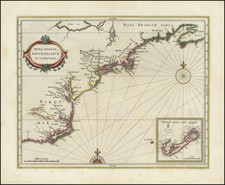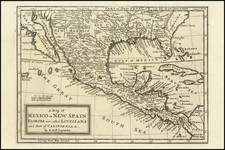An Important Revolutionary War Era Map of the Carolinas
Second edition (first French Edition) of Henry Mouzon's landmark 4-sheet map of the Carolinas, the primary source for the geographical details of the Carolinas for the American, English and French armies during the American Revolution.
Le Rouge published this French edition of the Mouzon map in his Atlas Amèriquain Sepentrionale, which was prepared in part to assist the French Military effort during the American Revolution. The map nomenclature is entirely in English, with titles in French and English and includes an inset of the English attack on Fort Sullivan (June 28, 1776), which was not present on either the original 1775 edition or the revised edition by Laurie & Whittle in 1794.
Mouzon's map was unquestionably the most important general map of the period. The map was utilized by three of the most important commanders of the American Revolution. George Washington's copy, folded and mounted on cloth, resides in the collections of The American Geographical Society. The French commander, the Comte de Rochambeau's copy belongs to the collections of the Library of Congress. British commander, Sir Henry Clinton's copy is held in the William L. Clements Library at the University of Michigan.
For several decades, Mouzon's map was a primary source for information about the geography and topography of the Carolinas, copied frequently by other mapmakers for its remarkable detail and accuracy. Mouzon based his map on years of personal surveying experience and over a decade spent critically assessing and incorporating previous information. As noted by Pritchard and Taliaferro, Mouzon's "appeared on the eve of the American Revolution, and its up-to-date geography made it the most widely consulted map of the area used in the war effort."
For North Carolina, Mouzon inserted for the first time Tryon County and Pelham County (later called Sampson). The topography west of the Catawba River is more detailed and accurate than on any previous map. Mouzon also advanced beyond earlier maps in his inclusion of rivers, streams, roads, and physical features like White Oak or Tryon Mountains and Kings Mountain.
For South Carolina, Mouzon added rivers and Indian settlements west of the Cherokee Indian boundary lines, and his depiction of the eastern precincts was more sophisticated than anything that had come before. Mouzon's map depicts forts, parishes, bridges, roads, Indian paths, and boundaries, and includes insets of Charleston and Port Royal harbors.
This is truly a landmark map. Its excellence and significant improvement of the depiction of the vast Carolinas was recognized by all countries involved in the Revolutionary War, and it remained unrivaled well into the 19th century.
Relatively little is known about Mouzon. At the time he was preparing the map, Mouzon, a professional surveyor, resided in Craven County, who died in April 1777, shortly after publication of his map. As noted in the Craven County Digital History Exhibit:
Mapmaker and civil engineer, Henry Mouzon, Jr. (1741-1807) was the grandson of a Huguenot immigrant to South Carolina who held land grants in Berkeley County. Henry, Jr. was born in Craven (now Williamsburg) County, South Carolina. After his father's death in 1749, eight-year-old Henry Jr. was sent to France for his education, where it is presumed that he learned mapmaking skills. He received his first important public commission in 1771, when he and Ephraim Mitchell (subsequently the surveyor general of South Carolina) were appointed by Governor Lord Charles Greville Montague to survey the boundaries of the civil districts of South Carolina.
The first notice of Mouzon's work was announced in an advertisement in THE SOUTH CAROLINA AND AMERICAN GENERAL ADVERTISER in May 1774, which announced his intention to publish a map of South Carolina only in January 1775. After expanding the scope to both North and South Carolina, Mouzon's map was first published by Sayer & Bennett in 1775.
Mouzon's map is derived from a number of sources. His depiction of South Carolina is based upon James Cook's, A MAP OF SOUTH CAROLINA (1771) and A MAP OF THE PROVINCE OF SOUTH CAROLINA (1773) and William De Brahm's MAP OF SOUTH CAROLINA AND A PART OF GEORGIA (1757). Mouzon added greater definition of the rivers and more detail regarding the native settlements located to the west of the Cherokee Line. For his treatment of North Carolina, Mouzon used John Abraham Collets' A COMPLEAT MAP OF NORTH- CAROLINA (1770), adding counties and better detail for the Catawba River and its tributaries. Mouzon also had access to other manuscript sources for his treatment of the North Carolina Coastline, as the hydrographic information varies significantly from Collet's map.
Rarity
The French edition of Mouzon's map was prepared primarily for use by French Military purposes in support of the American forces during the American Revolution is much rarer than the English edition. The English edition does not include the inset maps.
George-Louis Le Rouge (1712-1790), though known for his work in Paris, was originally born Georg Ludwig of Hanover, Germany. He grew up and was educated in Hanover, after which he became a surveyor and military engineer. Around 1740, however, Le Rouge moved to Paris and set up shop as an engraver and publisher on the Rue des Grands Augustins. It was at this time that he changed his name, adopting a French pseudonym that would later become quite famous.
Le Rouge spent much of his forty-year career translating various works from English to French, and his cartographic influence often came from English maps. His experience as a surveyor and engineer in Germany made him a skilled and prolific cartographer, and he produced thousands of charts, maps, atlases, and plans. His work spans from garden views and small-town plans to huge, multiple-continent maps. Le Rouge eventually accepted the position of Geographical Engineer for Louid XV, the King of France.
Later in life, Le Rouge became well-known for publishing North American maps, such as in his Atlas ameriquain septentrional of 1778. One of Le Rouge’s other more famous works is the Franklin/Folger chart of the Gulf Stream, which he worked on with Benjamin Franklin. Franklin and Le Rouge corresponded around 1780 and collaborated to create this map, a French version of Franklin’s famous chart which was originally printed in 1769.











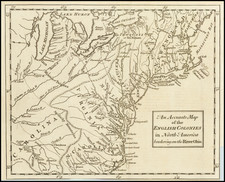
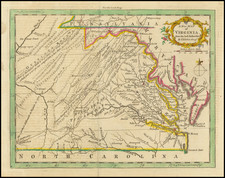
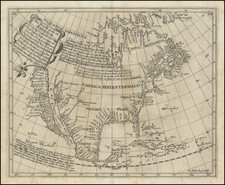
![[ Yorktown ] Plan of the Siege of York Town in Virginia . . .](https://storage.googleapis.com/raremaps/img/small/102061.jpg)
